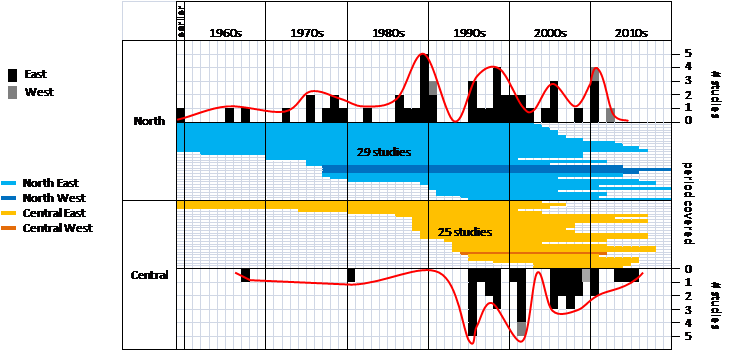In the second of our feature articles from the Fourth Symposium on Decadal Variability of the North Atlantic and its Marine Ecosystems, Antonio Bode, Instituto
Español de Oceanografía (IEO-CSIC), Spain, elaborates on his keynote lecture Plankton in the new millennium: synchronic multidecadal trends and regime shifts, which opened Theme Session 2: Decadal change and trends in North Atlantic/sub-Arctic
plankton and their ecosystems.
Recent changes in oceanic plankton are being reported at unprecedented rates. Most changes are related to environmental factors and many were identified as driven by climate, either through natural cycles or by anthropogenic effects. However, the separation of both effects is difficult because of the small size of most observational series. Moreover, some changes are related to trends and cycles while others were perceived as abrupt ecosystem shifts, often synchronized over large spatial scales.
A compilation of long-term studies on observational series of plankton, with a focus on the North Atlantic, will be presented during the 4th Symposium on Decadal Variability of the North Atlantic and its Marine Ecosystem: 2010-2019 (20–22 June 2022, Bergen, Norway). Among the 54 analyses reviewed, two main shift periods in species assemblages were identified in recent decades: one in the late-1980s and a more recent one in the first decades of the new millennium. The former mainly affected areas north of 50°N while the most recent shifts were reported for the whole North Atlantic (see figure below). These shifts also occurred in other regions of the Northern Hemisphere.

Summary of the studies analyzing regime shifts in plankton assemblages of the North Atlantic using observational series. The vertical bars indicate the number of shifts reported for each year and the horizontal bars indicate the period covered by each analysis. The North Atlantic was divided into four subregions: North East, North West, Central East, and Central West. The red line indicates the smoothed trend of the modes. Click to enlarge.
Response of plankton to changes in warming and in large-scale climatic factors
The potential drivers and the spatial extent of these shifts vary at local and subregional scales, but their synchronization seems to confirm the response of plankton to changes in warming and in large-scale climatic factors. For instance, changes in species abundance patterns are generally related to the strength of currents but also to non-linear effects of warming, the latter particularly affecting species in regions near the limits of their thermal niche. Indeed, most of the changes are increasingly attributed to trade-offs between different biological strategies. Recent analysis focuses on modelling species-specific responses to a major driver (e.g. warming) to predict changes in the assemblages at various spatial and temporal scales. These responses are based on the changes in the ecological niche occupied by each species as a result of the environmental forcing but also on the modified biological interactions with other species. In addition, the possible effects of extreme events (e.g. El Niño/La Niña, heatwaves, etc.) on the reorganization of planktonic communities in the North Atlantic are largely unknown.
Future understanding
Taken together, the reviewed case studies indicate a lagged biological response to variations in the local environment driven by large-scale climate forcing. The challenges for the interpretation of future states of the planktonic communities include the consideration of local changes in a wider regional context, variations in species life traits, and species interactions (e.g. competition and predation, but also fisheries). Furthermore, the predictions based on niche and life-trait characteristics would allow for new hypothesis-driven analyses of the observational series. However, while there is good coverage of the plankton observations in the Northern Hemisphere, there is a lack of field observations in most of the global ocean. A full understanding of the global connectivity and synchronization of these shifts would require expanding the spatial coverage of these series to other oceanic regions, as they would provide the necessary data for testing the model predictions.
The Fourth Symposium on Decadal Variability of the North Atlantic and its Marine Ecosystems: 2010–2019 runs from 20–22 June 2022 in Bergen, Norway.

